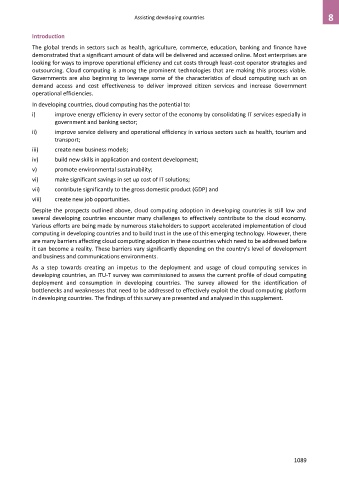Page 1097 - Cloud computing: From paradigm to operation
P. 1097
Assisting developing countries 8
Introduction
The global trends in sectors such as health, agriculture, commerce, education, banking and finance have
demonstrated that a significant amount of data will be delivered and accessed online. Most enterprises are
looking for ways to improve operational efficiency and cut costs through least-cost operator strategies and
outsourcing. Cloud computing is among the prominent technologies that are making this process viable.
Governments are also beginning to leverage some of the characteristics of cloud computing such as on
demand access and cost effectiveness to deliver improved citizen services and increase Government
operational efficiencies.
In developing countries, cloud computing has the potential to:
i) improve energy efficiency in every sector of the economy by consolidating IT services especially in
government and banking sector;
ii) improve service delivery and operational efficiency in various sectors such as health, tourism and
transport;
iii) create new business models;
iv) build new skills in application and content development;
v) promote environmental sustainability;
vi) make significant savings in set up cost of IT solutions;
vii) contribute significantly to the gross domestic product (GDP) and
viii) create new job opportunities.
Despite the prospects outlined above, cloud computing adoption in developing countries is still low and
several developing countries encounter many challenges to effectively contribute to the cloud economy.
Various efforts are being made by numerous stakeholders to support accelerated implementation of cloud
computing in developing countries and to build trust in the use of this emerging technology. However, there
are many barriers affecting cloud computing adoption in these countries which need to be addressed before
it can become a reality. These barriers vary significantly depending on the country's level of development
and business and communications environments.
As a step towards creating an impetus to the deployment and usage of cloud computing services in
developing countries, an ITU-T survey was commissioned to assess the current profile of cloud computing
deployment and consumption in developing countries. The survey allowed for the identification of
bottlenecks and weaknesses that need to be addressed to effectively exploit the cloud computing platform
in developing countries. The findings of this survey are presented and analysed in this supplement.
1089

